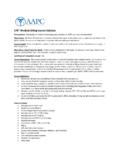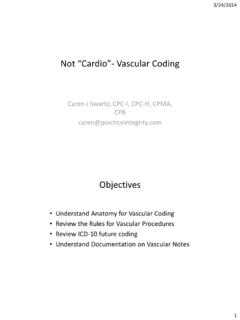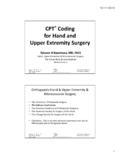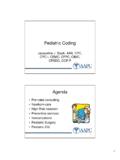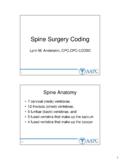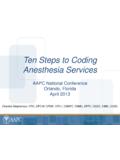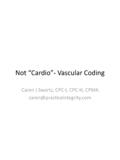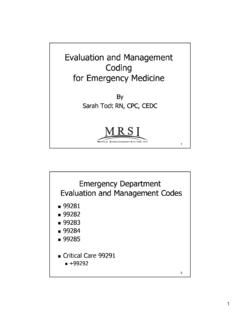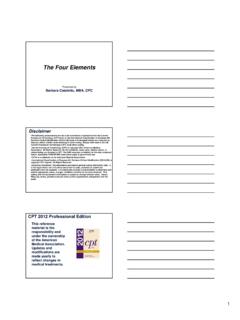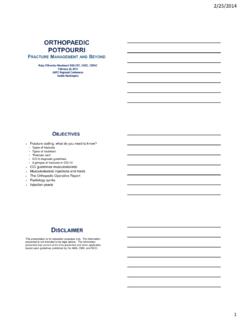Transcription of CARDIOVASCULAR SYSTEM CODING MADE EASY
1 9/13/20111 CARDIOVASCULAR SYSTEMCODING MADE EASYT eresa Marshall, CCSJ acqueline Woeppel, MBA, RHIA, CCSAAPC Regional ConferenceSeptember 9, 2011 CARDIOVASCULAR Agenda billing and CODING Policy Modifiers and Medical Necessity Nuts and Bolts PET Stress Tests Nuclear Stress Tests Echo cardiac catheterization cardiac Intervention ICD-9-CM Update and Revisions ICD-10-CMPhoto : Legal NCD vs. LCD CAHABA Government Benefit Administrator National Correct CODING Initiative CODING Policy Manual for Medicare Services. , Modifiers, and Medical Necessity Introduced to provide additional information Resource: CMS Claims Processing Manual (PUB 100-04) Chapter 1, section and Cahaba Government Benefit Administration #549/13/20113 Medicare, Modifiers and Medical Necessity GA Modifier When to use the GA modifier?
2 Item or service expected to be denied as not reasonable and necessary ABN--Waiver of liability on file Required to be reported on claim when Signed ABN on file or Patient s refusal with witnessed documentation Is the patient responsible if the claim is denied? Beneficiary is NOT liable if ABN was not signed prior to the service being rendered Beneficiary is responsible with ABN ( other insurance)5 Medicare, Modifiers and Medical Necessity Modifier GY When to use modifier? When you expect a denial Excluded or definition Obtain Medicare denial for secondary payor No ABN requirements What happens if you use GY modifier?
3 Create an automatic denial Patient is liable for charges Personally or via other insurances If you do not use GY Modifier Claim Reviewed Beneficiary may be liable Excluded service or definition69/13/20114 Medicare, Modifiers and Medical Necessity Modifier GZ When to use GZ modifier? Item or service does not meet Medicare policy standards for medical necessity and no ABN was obtained Expect a service to be denied Patient refused an ABN, but service provided What happens when GZ modifier is used? Claim will be reviewed If claim denied Patient generally not liable Modifier is voluntary Reduce risk7 Other Insurance ProvidersDiagnosis/CPTM edical PolicyCarrier Manual89/13/20115 CARDIOVASCULAR Test PET Stress Test Advanced stress test utilizing small amounts of tracer injected into blood stream Ischemia CAD Nuclear Stress Test Radioactive exercise stress test Size Pumping blood Damaged or dead muscle Arteries (narrowed or blocked) Echocardiogram (ECHO)
4 Sound waves creates a motion picture of the heart Size and shape of the heart How well the heart is working ( contracting, blood flow)9 PET Perfusion TestIndication:Multiple cardiac risk factors and cardiomyopathy. Technique: Perfusion PET images were acquired at rest. Low-dose noncontrasted CT transmission images were acquired for attenuation correction. Following an IV infusion of insulin and dextrose. F-18-FDG was administered intravenously and PET images representative of myocardial glucose metabolism were acquired. The fasting blood glucose was 99 mg/dl.
5 Rest dose of Rubidium-82 (mCi): and Rest dose of F-18 FDG (mCi): Findings: Quality of the study was good. Rest LVEF was 29%. Wall motion abnormalities: global hypokinesis with severe hypokinesis of the inferior wall. The PET perfusion images demonstrate a large zone of moderately decreased activity along the inferior wall. The FDG images demonstrate a matched severe metabolic defect concordant with the perfusion defect with no significant mismatch. Impression: 1) The fixed perfusion abnormality involving the inferior wall is most consistent with myocardial scarring.
6 The matching FDG metabolic defect is confirmatory of myocardial scarring with no evidence of hibernating for chronically ischemic myocardium. 2) The global left ventricular systolic function is severely compromised with a left ventricular ejection fraction of 29% and marked LV dilatation. There is global hypokinesis and severe hypokinesis of the inferior wall. 3) There is no prior study available for comparison. 4) The low-dose, noncontrasted, limited field-of-view CT demonstrates cardiomegaly, aortic valve calcifications, mild coronary artery calcifications.
7 109/13/20116 PET Perfusion TestIndication:Multiple cardiac risk factors and cardiomyopathy. Technique: Perfusion PET images were acquired at rest. Low-dose noncontrasted CT transmission images were acquired for attenuation correction. Following an IV infusion of insulin and dextrose. F-18-FDG was administered intravenously and PET images representative of myocardial glucose metabolism were acquired. The fasting blood glucose was 99 mg/dl. Rest dose of Rubidium-82 (mCi): and Rest dose of F-18 FDG (mCi): Findings:Quality of the study was good.
8 Rest LVEF was 29%. Wall motion abnormalities: global hypokinesis with severe hypokinesis of the inferior wall. The PET perfusion images demonstrate a large zone of moderately decreased activity along the inferior wall. The FDG images demonstrate a matched severe metabolic defect concordant with the perfusion defect with no significant mismatch. Impression:1) The fixed perfusion abnormality involving the inferior wall is most consistent with myocardial scarring. The matching FDG metabolic defect is confirmatory of myocardial scarringwith no evidence of hibernating for chronically ischemic myocardium.
9 2) The global left ventricular systolic function is severely compromised with a left ventricular ejection fraction of 29% and marked LV dilatation. There is global hypokinesis and severe hypokinesis of the inferior wall. 3) There is no prior study available for comparison. 4) The low-dose, noncontrasted, limited field-of-view CT demonstrates cardiomegaly, aortic valve calcifications, mild coronary artery calcifications.. CODE(S): (1) (2) (3) (4) (1) 78491-26 (2) 78459-2611 Nuclear Stress Test129/13/20117 Nuclear Perfusion Study--ExampleINDICATION:Chest PORTION: Patient underwent a Lexiscan nuclear perfusion study for suspected coronary artery disease.
10 During the Lexiscan infusion, the patient was given 27 mCi of technetium-99m sestamibi for visualization of myocardium in standard different planes. Resting EKG shows normal sinus rhythm, has been changed to sinus tachycardia without ischemic EKG changes toward the end of the test. Resting heart rate is 80 beats per minute, has been changed to 108 beats per minute towards the end of the test. Resting blood pressure is 170/100, has been changed to 172/98 towards the end of the test. No significant malignant arrhythmias : 1) Test was negative for chest pain.
